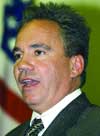Copper wires phone home

Optical fiber is the future, but old-fashioned copper wiring can still carry plenty of juice ? especially now that the new IEEE 802.3ah standard has taken effect.

Craig Easley, metropolitan-area Ethernet director at Extreme Networks, predicted EFM would become "the next wave of broadband."
Rick Steele
The standard enables agencies and integrators to use copper wiring and Ethernet protocol to deliver better-than-T1 data throughput to locations where fiber hasn't yet been rolled out.
The IEEE 802.3ah standard for Ethernet in the first mile (EFM), ratified in July, will make it possible to extend TCP/IP far beyond local networks by attaching special modems to phone wiring.
"Ethernet is ubiquitous for LANs," said Craig Easley, president of the Ethernet in the First Mile Alliance and the metropolitan-area Ethernet director at Extreme Networks Inc. of Santa Clara, Calif. "It just took a little work to extend it to WANs" with existing copper phone pairs.
EFM WANs built so far are serving a few military bases, metropolitan areas, campuses and remote offices, but Easley said the technology could grow to fill in the last-mile gap between offices and homes and the telecommunications carriers' underused fiber core.
"There's a huge excess capacity" of fiber core amounting to terabits per second, he said, because of the industry's fiber overexpansion before the recession.
Easley predicted EFM would become "the next wave of broadband."
All computers have Ethernet interfaces, he said, "so end-to-end Ethernet makes tremendous sense." It eliminates the TCP/IP protocol translations and encapsulations necessary for packet transport over frame relay, asynchronous transfer mode or Synchronous Optical Network.
The standard "squeezes out complexity. It's all one technology from end to end," Easley said.
Ethernet also is cheaper than other alternative broadband technologies, said Ken Williams, president of Allied Telecom Group LLC of Washington.
A 1.5-Mbps T1 line typically costs $450 to $700 per month, and a 45-Mbps T3 line costs $4,500 to $7,000 per month, Williams said. T1 and T3 Internet services have two components: the costs of a local loop to a telecommunications carrier and a bandwidth charge by the Internet provider.
Williams said EFM over existing copper pairs can give as much capacity as a fractional T3 while eliminating the cost of the local loop. "A 10-Mbps EFM over copper link runs around $1,500 per month," he said.
In a demonstration arranged by Brett Bobley, chief information officer of the National Endowment for the Humanities and co-chairman of the Small Agency CIO Council, Allied Telecom showed EFM streaming video of street traffic from a camera at 13th and L Streets in Washington.
Using the National Endowment's EFM connection in the Old Post Office Pavilion on Pennsylvania Avenue, Williams remotely controlled the camera's tilt and zoom. The EFM connection also fed a Web browser and a Cisco Systems Inc. voice over IP phone.
To demonstrate the built-in redundancy of phone wiring, Williams snipped out one, two and then three of the four copper pairs without losing the video, Web connection or dial tone. When the EFM link was cut down to one pair, the streaming video became choppy but continued showing traffic clearly.
Williams said he recommends EFM not only for videoconferencing and surveillance but also for remote backup for disaster recovery. As a market, he said, EFM is "a huge opportunity, because organizations need more and more bandwidth."
In metropolitan areas with plentiful copper wiring, EFM provides data networking without interference to phone systems. But if an organization chooses to adopt VoIP as well, it must install new Ethernet ports for its users to prioritize different kinds of voice and data traffic.
Multiple copper pairs can be aggregated into a so-called fat pipe to provide 2 Mbps to 40 Mbps of EFM bandwidth over distances up to a mile or so.
Point-to-point EFM requires connecting the copper pairs at each end to a modem device, such as the MetaLight series from Actelis Networks Inc. of Fremont, Calif.
Actelis Vice President Yossi Saad said the Army's 1st Infantry Division stationed in Iraq set up a headquarters network in one of Saddam Hussein's presidential palaces by simply "pulling regular copper pairs and putting our boxes at the ends. They didn't want to have to splice fiber."
The great advantage of EFM over cable and digital subscriber line broadband, according to Saad, is "business-class service. DSL is a best-effort service; it's not guaranteed," he said. But an EFM quality-of-service guarantee for bandwidth and uptime can be set up contractually, he said.
Another advantage, Easley said, is that EFM has the potential to isolate the carrier's equipment from the customer's equipment for remote troubleshooting of line quality and bit errors.
A device similar to the "smart jack" used for diagnosing T1 line problems can be attached to the customer's wiring intake point. "Ethernet has never had such a tool before," Easley said. n
Susan Menke is a technology writer with Government Computer News. She can be reached at smenke@postnewsweektech.com.
NEXT STORY: News briefs: On the Edge